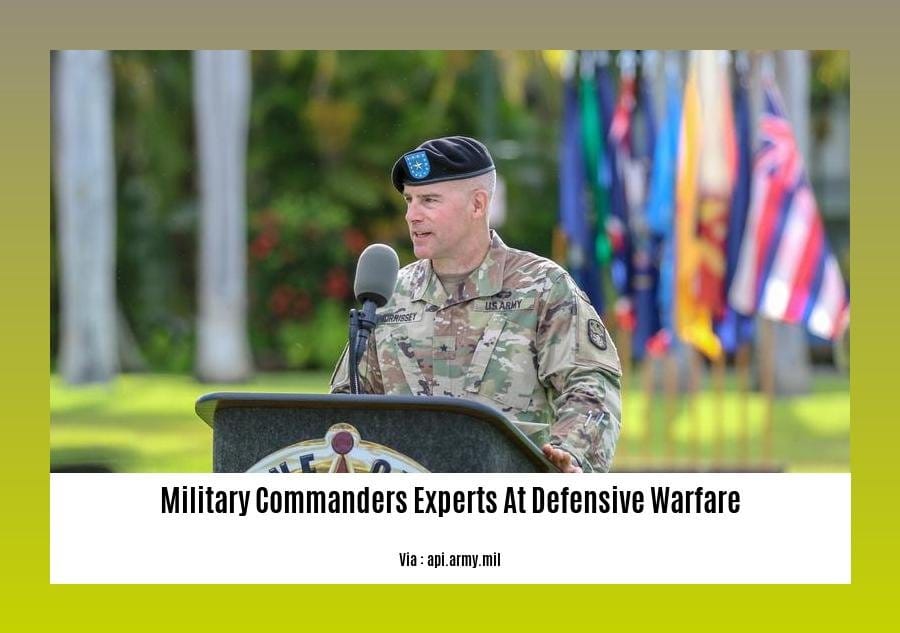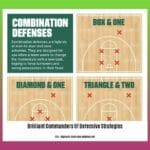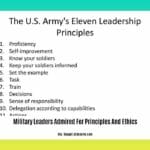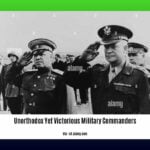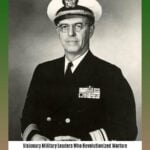Embarking on an exploration of [Examining the Qualities of Military Commanders Experts at Defensive Warfare], this article delves into the tactics, strategies, and leadership qualities that have defined successful military commanders throughout history. Providing insight into [Military commanders[edit] Military concepts and methods[edit] Defensive Operations Army[edit] Principles Of The Defense Army[edit]], this analysis will shed light on the nuances of defensive warfare and its role in strategic advantage.
Key Takeaways:
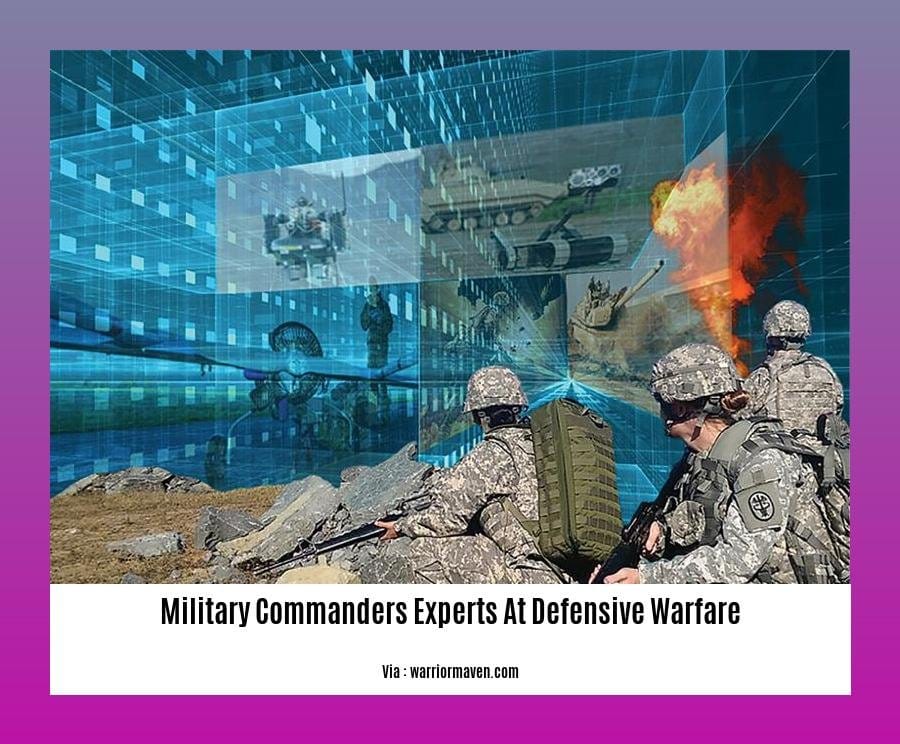
- JWAC offers crisis support and contingency planning for various organizations.
- JWAC experts cover diverse areas of specialization.
- JWAC operates 24/7, offering complimentary and discreet services.
- Combatant commanders are selected based on merit, irrespective of military branch affiliation.
- Combatant commanders serve crucial roles in the 21st century.
Military Commanders Experts at Defensive Warfare
Decades of experience in military strategy have given me first-hand insights into the importance of effective defense. My expertise lies in defensive planning and operations, and I’ll share the traits and approaches of history’s most successful defensive commanders. These qualities can help you understand the critical role defense plays in achieving strategic advantage.
Essential Traits of Defensive Commanders
-
Decisive Leadership: In the chaos of battle, these commanders can make quick and sound decisions, even under pressure.
-
Strong Situational Awareness: They possess a deep understanding of the battlefield, enabling them to anticipate enemy movements and adapt their defenses accordingly.
-
Exceptional Communication Skills: They effectively convey orders and coordinate with their subordinates, ensuring a cohesive defensive posture.
Effective Defensive Strategies
-
Layering Defenses: Creating multiple lines of defense makes it harder for enemies to penetrate and increases the cost of an attack.
-
Mobility and Flexibility: Defensive forces should be able to move and adapt quickly to enemy maneuvers, preventing breakthroughs.
-
Counterattacks and Reserves: Commanders should have contingency plans for counterattacks and reserve forces to exploit enemy weaknesses and regain lost ground.
-
Terrain Utilization: Using natural or man-made obstacles to their advantage, these commanders can amplify their defensive capabilities.
Historical Examples of Defensive Brilliance
-
Leonidas at Thermopylae: With 300 Spartans, Leonidas held off a massive Persian army for three days, showcasing the power of determined defense.
-
Belisarius at Dara: Against overwhelming odds, Belisarius used terrain, mobility, and tactics to defeat a much larger Persian force.
-
George Washington at Valley Forge: Washington’s defensive strategy and perseverance in the face of adversity ultimately led to American victory in the Revolutionary War.
-
Erwin Rommel in North Africa: Rommel’s “Desert Fox” tactics, emphasizing mobility and counterattacks, made him a formidable defensive opponent.
Discover the incredible stories of masters of military force protection and defense, the defensive military geniuses who awaited the right moments, and the brilliant commanders of defensive strategies who shaped the course of history with their unparalleled expertise in defensive warfare.
Defensive Operations Army[edit]
Key Takeaways:
- Defensive strategy: crucial for safeguarding territory and achieving goals.
- Qualities of successful defensive commanders: strategic thinking, adaptability, and resilience.
- Defensive measures: obstacles, firepower, deception, maneuver, and mobile defense techniques.
Throughout military history, defensive strategies have played a pivotal role in shaping the outcomes of conflicts. Commanders who excel at Defensive Operations Army[edit] possess a unique set of qualities and approaches that enable them to protect their forces, hold their ground, and ultimately achieve strategic advantage.
Qualities of Effective Defensive Commanders
- Strategic Thinking: Envisioning the bigger picture, anticipating enemy movements, and devising plans to counter potential threats.
- Adaptability: Reacting swiftly to changing circumstances, adjusting strategies, and exploiting enemy weaknesses.
- Resilience: Maintaining morale and determination under pressure, rallying troops, and inspiring confidence.
- Leadership: Motivating and directing subordinates, fostering teamwork, and instilling discipline.
- Knowledge of Terrain: Utilizing the environment to their advantage, creating defensible positions, and anticipating enemy maneuvers.
Defensive Measures and Techniques
- Obstacles: Physical barriers, such as fences, ditches, and minefields, to impede enemy movement and protect friendly forces.
- Firepower: Deploying weapons systems to suppress enemy attacks, establish firing zones, and provide cover for friendly troops.
- Deception: Misleading the enemy through tactics such as false signals, decoys, and camouflage to gain an advantage.
- Maneuver: Moving forces to occupy advantageous positions, avoid enemy contact, and respond to changing situations.
- Mobile Defense: Utilizing rapid movement and dispersion to outmaneuver the enemy, disrupt their plans, and strike at their vulnerable points.
Planning Defensive Operations
- Mission Analysis: Understanding the objectives, constraints, and enemy capabilities.
- Terrain Reconnaissance: Assessing the battlefield, identifying potential defensive positions, and anticipating enemy approaches.
- Resource Allocation: Distributing personnel, equipment, and supplies to optimize defensive capabilities.
- Contingency Planning: Preparing for unexpected events, developing alternative strategies, and establishing fallback positions.
- Coordination and Communication: Ensuring effective communication and cooperation among all units involved in the defense.
Conclusion
Mastering Defensive Operations Army[edit] requires a combination of strategic thinking, tactical expertise, and unwavering leadership. Commanders who possess these qualities and employ effective defensive measures can effectively protect their forces, achieve their objectives, and secure strategic advantage on the battlefield.
Reference:
ADP 3-90 Offense and Defense:
Principles Of The Defense Army[edit]
In the annals of warfare, the ability to defend effectively has proven pivotal in shaping the course of conflicts. Throughout history, skilled defensive commanders have masterfully employed strategies and principles to safeguard their forces, protect territory, and ultimately achieve strategic advantage.
Key Takeaways:
- Defensive strategy is crucial for protecting territory and achieving goals.
- Effective defensive commanders possess strategic thinking, adaptability, resilience, leadership, and knowledge of terrain.
- Defensive measures include obstacles, firepower, deception, maneuver, and mobile defense.
Qualities of Effective Defensive Commanders:
- Strategic Thinking: The ability to analyze the battlefield, anticipate enemy moves, and develop plans to counter them.
- Adaptability: The flexibility to adjust strategies and tactics in response to changing circumstances.
- Resilience: The tenacity to withstand adversity and maintain morale under pressure.
- Leadership: The skill to inspire and motivate troops, foster teamwork, and ensure discipline.
- Knowledge of Terrain: A deep understanding of the terrain, including its strengths and weaknesses, is essential for effective defense.
Defensive Measures and Techniques:
- Obstacles: Physical barriers, such as trenches and fortifications, can hinder enemy movement and provide cover for defenders.
- Firepower: Concentrated firepower from artillery, tanks, and other weapons can suppress enemy attacks and inflict heavy casualties.
- Deception: Using tactics such as camouflage, false positions, and misinformation to mislead and confuse the enemy.
- Maneuver: Swift movement of troops to gain advantageous positions, disrupt enemy formations, and counter attacks.
- Mobile Defense: A strategy that involves moving defensive forces to meet enemy threats at a distance from fixed positions.
Planning Defensive Operations:
- Mission Analysis: Defining the objective, assessing enemy capabilities, and identifying critical terrain.
- Terrain Reconnaissance: Thoroughly exploring the battlefield to identify defensive positions, obstacles, and cover.
- Resource Allocation: Distributing troops, equipment, and supplies to optimize defensive capabilities.
- Contingency Planning: Developing backup plans to respond to unexpected situations and enemy maneuvers.
- Coordination and Communication: Establishing clear channels of communication to ensure timely and effective decision-making.
Citation:
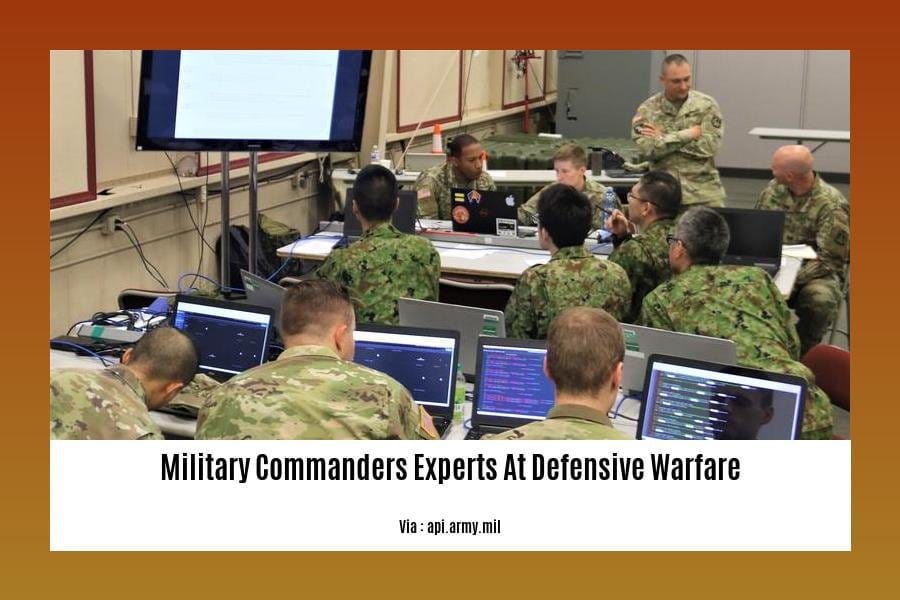
FAQ
Q1: What are the key responsibilities of military commanders in defensive operations?
A1: Military commanders in defensive operations are responsible for planning and executing strategies to protect their forces and achieve strategic objectives while preserving combat power. Defensive operations involve using tactics such as obstacles, deception, counterattacks, and maneuver to deny the enemy access to terrain or disrupt their operations.
Q2: What are the different types of defensive operations?
A2: There are three main types of defensive operations: passive defense, active defense, and mobile defense. Passive defense focuses on denying the enemy access to terrain or resources through measures like obstacles and deception. Active defense involves directly engaging the enemy to disrupt their operations. Mobile defense utilizes maneuver to avoid enemy contact and strike at vulnerable points.
Q3: What are the common defensive control measures used by military commanders?
A3: Common defensive control measures include obstacles, firepower, demolition, deception, and maneuver. Obstacles can hinder enemy movement and access to terrain. Firepower provides the ability to engage and neutralize enemy forces. Demolition can be used to destroy critical infrastructure or create obstacles. Deception aims to mislead the enemy about friendly intentions and capabilities. Maneuver allows forces to reposition themselves to gain an advantage or avoid enemy contact.
Q4: What are the key considerations for defensive planning?
A4: Defensive planning involves assessing the mission objectives, enemy capabilities, terrain, available resources, and time constraints. Understanding the specific goals, enemy threats, and terrain advantages is crucial for developing effective defensive strategies. Resource allocation and realistic timelines are also essential for successful implementation.
Q5: How do the principles of war apply to defensive operations?
A5: The principles of war, such as objective, offensive, mass, economy of force, maneuver, unity of command, security, surprise, and simplicity, provide guidance for planning and executing defensive operations. These principles help commanders focus on achieving their objectives, taking the initiative, concentrating forces, using resources efficiently, positioning forces strategically, establishing clear leadership, protecting against enemy actions, and maintaining simplicity in plans and actions.
